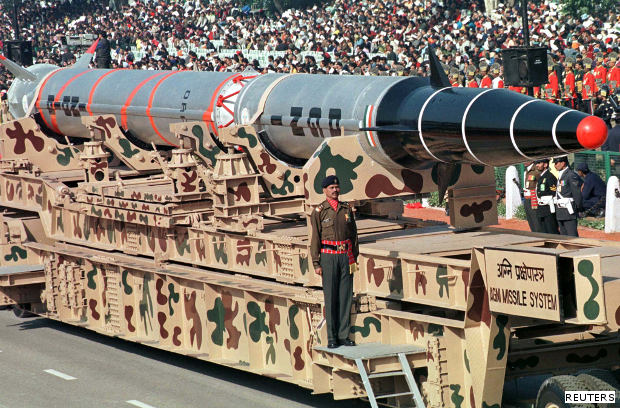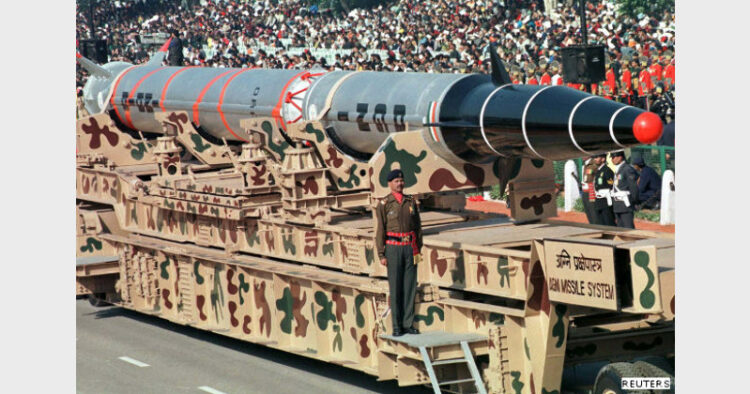We must begin by exploring how the NFU policy has become a limitation on India’s deterrence capability against the threats posed by Pakistan, China, and other non-state actors.
– Nikhil Gowda

(The article is reproduced from the author’s post at https://mpp.nls.ac.in/blog/rebooting-indias-nuclear-doctrine/)
Twenty-two years ago, on 11 May 1998, India conducted a set of five nuclear tests in Pokhran that comprised of one fusion bomb and four fission bombs under the name Operation Shakti. Shortly after the success of these tests, the then Prime Minister Atal Bihari Vajpayee declared India as a full-fledged nuclear state. The global world order condemned the nuclear tests which evoked sanctions from some countries including USA and Japan, who suspended all forms of economic aid to India.
The challenge before India was to generate acceptance as a responsible nuclear power. Therefore, the government came out with its nuclear doctrine in 2003, the components of which can be summarised as follows (Nuclear Doctrine of India, 2003):
1. Building and maintaining a credible minimum deterrent;
2. A posture of “No First Use (NFU)”: nuclear weapons will only be used in retaliation against a nuclear attack on Indian territory or on Indian forces anywhere;
3. Nuclear retaliation to a first strike will be massive and designed to inflict unacceptable damage.
4. Nuclear retaliatory attacks can only be authorised by the civilian political leadership through the Nuclear Command Authority.
5. Non-use of nuclear weapons against non-nuclear weapon states;
6. However, in the event of a major attack against India, or Indian forces anywhere, by biological or chemical weapons, India will retain the option of retaliating with nuclear weapons;
7. A continuance of strict controls on export of nuclear and missile related materials and technologies, participation in the Fissile Material Cutoff Treaty negotiations, and continued observance of the moratorium on nuclear tests.
8. Continued commitment to the goal of a nuclear weapon free world, through global, verifiable and non-discriminatory nuclear disarmament
The Nuclear doctrine was an attempt to gain legitimacy as a responsible nuclear power. One can say that the doctrine has been able to meet the challenge – as presently most countries recognise India as a responsible nuclear power. This can be validated by the India-USA nuclear agreement of 2005, an offer which the USA has not made to any other non-signatory to the Nuclear Non-Proliferation Treaty (NPT). Strobe Talbott – an American Foreign Policy Analyst – has argued in his memoirs that US considers India’s Nuclear doctrine as proof for India being as a responsible nuclear power. In 2015, likewise, Japan & India signed a memorandum of understanding for Civil-Nuclear Co-operation overcoming the reservations over India’s status as a nation which has not signed NPT.
However, questions have been raised consistently about the rationale behind NFU Policy by political leaders such as former Defence Minister Manohar Parrikar, the current Defense Minister Rajnath Singh, and strategic experts such as Bharat Karnad, in light of India’s national security considerations.
Mutually Assured Destruction (MAD) holds good only between two nation states, and doesn’t deter non-state actors such as terror groups from using nuclear weapons.
Bharat Karnad, a prominent strategic expert, has argued that the NFU policy is not useful because a nuclear weapon cannot be designed only for a second strike. Secondly, the NFU posture would make sense only when a country has extremely high survival chance from first strike, and then has sufficient resources for a retaliatory strike. Karnad, therefore, argues for abandoning a policy of no first use. Even in 1998 when the National Security Board was debating on the draft nuclear doctrine, some members had openly argued against NFU Policy. However, the debate was settled in favor of NFU given the realities at that time. Today, given the changing security scenario in South Asia, there is view that the NFU is a compromise on India’s security, which faces a perpetual threat from the two nuclear-armed neighbouring countries of Pakistan & China. With recent aggressive incursions by China at Galwan valley, calls for strategic policymakers, to rethink over the relevance of NFU policy in India’s nuclear doctrine.
Limitations Imposed by NFU Policy
We must begin by exploring how the NFU policy has become a limitation on India’s deterrence capability against the threats posed by Pakistan, China, and other non-state actors. Since both India and Pakistan went on to become nuclear-power states, we see that unlike India, Pakistan doesn’t endorse NFU of nuclear weapons which has helped Pakistan to overcome the edge that India possesses in terms of conventional military strength. Pakistan has successfully exploited India’s NFU policy through waging covert low intensity warfare such as militancy and infiltration, and any attempt for a conventional military response from India’s end has been stymied by Pakistan’s blackmail of a nuclear attack. This was witnessed in the case of Parliament attack in 2001 & Mumbai attack in 2008.
The other important concern that India’s security faces is that, in recent years, many terror groups have been making attempts to access nuclear weapons. Matthew Bun – an American nuclear policy analyst – in his research has documented that Osama bin Laden had once said that acquiring nuclear & chemical weapons was a religious duty. Terror groups, such as Al-Qaeda, have made attempts to buy stolen nuclear material in their pursuit to make a nuclear weapon. According to US intelligence agencies shortly before the 9/11 attacks two Pakistani nuclear scientists who were extremist sympathizers met with Laden and Ayman al-Zawahiri to discuss about making a nuclear weapon.
Now, in a hypothetical situation, if one were to consider that Pakistan gives necessary support to these terror groups to access & use nuclear weapons against the Indian state, in such a scenario India will have to provide sufficient evidence to prove Pakistan’s involvement before undertaking any nuclear strike against Pakistan. The other important point that has to be noted is that the nuclear deterrence based on Mutually Assured Destruction (MAD) holds good only between two nation states, and doesn’t deter non-state actors such as terror groups from using nuclear weapons. Hence, India should keep an open option of a preemptive strike.
In China’s case, we see that, India’s NFU policy is futile in addressing the security challenges posed by Beijing, even though China was the first nuclear armed state to moot for an NFU policy. NFU shifts the balance in favor of China, as China has the edge over India, in terms of conventional military strength. According to Lowy Institute’s Asia Power Index (which ranks countries based on military capabilities, economic resources & diplomatic influence) India lags behind China in every geopolitical metric.
The disparity in conventional military capabilities between India & China has been widening over the years. For instance, China’s defense budget in year 2019 was $177.61 billion, whereas during same period, India’s defense budget has been valued at $66.9 billion, according to the Stockholm International Peace Research Institute (SIPRI). We see that, Chinese defense budget is almost three times the size of India’s. India’s very own Comptroller and Auditor General (CAG) report has raised a red flag over India’s defense preparedness. For instance, India, at the current rate of defense procurement, could end up with only 22 squadrons, whereas Indian Air Force, needs 42 squadrons of jet, around 750 aircrafts to defend against a two-pronged attack from China & Pakistan. China nearly has one million more troops, five times more submarines and nearly twice as many warships than India. This shows that the conventional military power is heavily stacked in China’s favor, and India should device a strategy to deter a belligerent China along its border.
Beijing’s post- Covid19 aggression, pressing for territorial claims from the great Himalayas to the South China Sea, provides an opportunity for India’s strategists to rethink NFU policy in its nuclear doctrine.
Apprehensions raised by NFU Proponents
Proponents of NFU have argued that any attempt to do away with the legacy of NFU policy would have negative impact on India’s image as a responsible nuclear power, which has been built over the years with great effort by the foreign policymakers, diplomats and which has yielded results in form of membership to global nuclear regimes such as Missile Technology Control Regime (MTCR), Wassenaar and Australian Group. Secondly, it would further raise the apprehensions of India’s smaller neighbors such as Nepal, Bhutan and strengthen the perception of India’s image as a big brother. However, these apprehensions are misplaced. One must understand that India’s image of a responsible nuclear power is not solely built on the NFU policy. It is based on other factors such as India impeccable track record with respect to non-proliferation, and that the nuclear doctrine specifically mentions that India’s nuclear weapons will be never used against non-nuclear weapon states. Therefore, rescinding the NFU policy shouldn’t make the smaller and non- nuclear states to cause to worry.
Policy window is now open to rescind India’s NFU
Beijing’s post- Covid19 aggression, pressing for territorial claims from the great Himalayas to the South China Sea, provides an opportunity for India’s strategists to rethink NFU policy in its nuclear doctrine. Today, the US along with the European countries has been critical of Beijing’s aggression in the neighborhood. On the other hand, New Delhi’s diplomacy has been successful to a certain extent in exposing Pakistan’s nexus with the terror groups, as well as using militancy as a tool to wage a low-intensity war against India in the recent Uri and Pathankot attacks, which also provides legitimacy to rescinding the NFU policy.
The time is ripe for India to announce that the No First Use (NFU) policy in the doctrine would apply only to non-nuclear weapons state and keep the option open for a pre-emptive strike, in the case of nuclear-armed states.
Domestically the conditions are favorable to the ruling National Democratic Alliance (NDA) government to review the utility of NFU policy, because it has a majority unlike the United Progressive Alliance (UPA) regime, which was tied down by the coalition compulsions. As a matter of fact, the Bharatiya Janata Party (BJP) had mentioned in its 2014 election manifesto, that it would study “in detail” India’s nuclear doctrine and to make it relevant to the challenges of current times.
Conclusion
The time is ripe for India to announce that the No First Use (NFU) policy in the doctrine would apply only to non-nuclear weapons state and keep the option open for a pre-emptive strike, in the case of nuclear-armed states. This would infuse a sense of realism into India’s nuclear doctrine given the fact that India is the only country in the world to share borders with two nuclear armed states. Rescinding the NFU policy would act as deterrent against Pakistan’s low-intensity warfare, and against the increasing Chinese aggression along the border. This brings an element of calculated ambiguity and surprise in the New Delhi’s nuclear posture, as even an ancient strategic scholar Kautilya exclaims “Even when a snake is not poisonous, it should pretend to be venomous.”
(The author is a student of Master of Public Policy at the National Law School of India University. He is interested in politics, leadership and election strategies, and international relations)














Comments